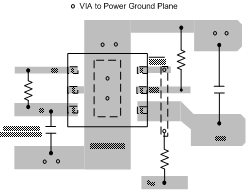SLVSCU5 March 2015 TPS25200-Q1
PRODUCTION DATA.
- 1 Features
- 2 Applications
- 3 Description
- 4 Simplified Schematic
- 5 Revision History
- 6 Pin Configuration and Functions
- 7 Specifications
- 8 Parameter Measurement Information
- 9 Detailed Description
- 10Application and Implementation
- 11Power Supply Recommendations
- 12Layout
- 13Device and Documentation Support
- 14Mechanical, Packaging, and Orderable Information
Package Options
Mechanical Data (Package|Pins)
- DRV|6
Thermal pad, mechanical data (Package|Pins)
- DRV|6
Orderable Information
12 Layout
12.1 Layout Guidelines
- For all applications, a 0.1-µF or greater ceramic bypass capacitor between the IN and GND pins is recommended as close to the device as possible for local noise decoupling.
- For output capacitance, see Figure 16. A low-ESR ceramic capacitor is recommended.
- The traces routing the RILIM resistor to the device should be as short as possible to reduce parasitic effects on the current-limit accuracy.
- The thermal pad should be directly connected to PCB ground plane using wide and short copper trace.
12.2 Layout Example
 Figure 32. TPS25200-Q1 Board Layout
Figure 32. TPS25200-Q1 Board Layout